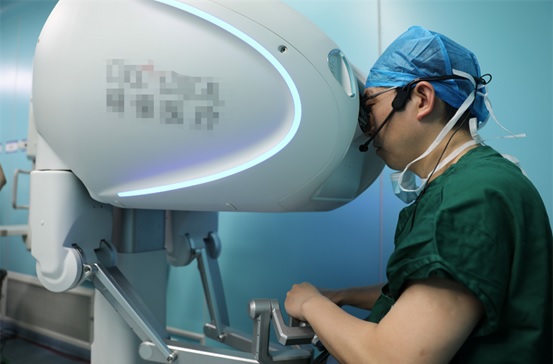By Qin Haifeng, People’s Daily
Recently, an domestically developed endoscopic surgery robot assisted two doctors to complete two challenging surgeries at the First People’s Hospital of Xiushui County, east China’s Jiangxi province.
Meanwhile, China’s first county-level demonstration center of robotic-assisted diagnosis and treatment was inaugurated in the county, which has laid a solid foundation for the future application of surgical robots in county-level hospitals across China.
The two surgeries were performed on the morning of April 23 by Wang Baojun, deputy chief physician and associate professor with the Chinese People’s Liberation Army General Hospital, and Wang Gongxian, professor with The First Affiliated Hospital of Nanchang University.
One of the patients was hospitalized because of a lump in the right adrenal gland. Since the big lump was very close to the inferior vena cava and had a high blood flow, the patient could face a high risk of bleeding during the surgery. Besides, the patient’s liver was large, which made it very difficult to perform the surgery.
Thanks to the assistance from the domestically developed endoscopic surgery robot, which offered clear and three-dimensional vision, Wang Baojun soon located the lump, removed it and stopped the patient’s bleeding. The surgery lasted only some 20 minutes.
The other surgery was a radical cystectomy for a senior patient with underlying diseases. Assisted by the robot, Wang Gongxian completed the surgery in just some three hours.
The two surgeries were livestreamed and viewed by medical workers from 36 township-level hospitals and some rural settlements in Xiushui county.
“They were overwhelming and difficult, and completely renewed our perception of diagnosis and treatment,” said Deng Qiulin, head of the medical administration office of the Zhajin township hospital of Xiushui county.
“It’s a rare opportunity for primary-level hospitals like ours to get close to such advanced medical technologies through the county-level hospital. The medical capability of Xiushui county has been on a rise over the recent years. From traditional laparotomy to endoscopic surgery, and to today’s robotic-assisted surgery, impairments caused by surgeries have been reduced, and patients are making faster recovery,” Deng noted.
The introduction of surgery robots has provided more options for local patients in Xiushui county. The county is one with inadequate transport facilities, so it’s inconvenient for residents with serious illnesses to seek medical services outside the county. Besides, robotic-assisted surgeries might be consideribly expensive in Nanchang, capital of Jiangxi province and first-tier cities, but the price is much lower in Xiushui. With the part that can be reimbursed by health insurance, patients won’t have to shoulder much expense.
The application of surgery robots makes it easier to perform higher-risk and precision-demanding operations in smaller spaces and important anatomical regions, which makes surgeries more efficient and convenient, helps reduce stress and fatigue of medical workers and lowers errors.
“Thanks to the application of the laparoscopic surgery robot, we are able to perform surgeries that we dared not to perform in the past and treat diseases that we couldn’t treat in the past,” said Xu Baisheng, an executive of the First People’s Hospital of Xiushui County.
According to Xu, the county-level demonstration center of robotic-assisted diagnosis and treatment established at the hospital, which is the first of its type in China, aims at providing theoretical training, clinical observation and other services related to surgery robots to county-level hospitals across the country.
It is expected to improve primary-level doctors’ recognition and skills of surgery robots and promote the popularization and application of surgery robots at primary-level health institutions, Xu said.
The application of surgery robots at county-level hospitals is of important significance. It not only improves these hospitals’ medical capability and meets the medical demands in rural and less developed areas, but also further balances the distribution of medical resources in urban and rural areas and thus promotes coordinated regional development.
“Sufficient training is needed before new technologies are put into use. We will set up alliances with first-class hospitals in China, reform the management models of operating theaters and the department of anesthesiology, establish professional teams of robotic-assisted surgery, and send relevant personnel to other institutions for further study, so as to make sure that patients in the county can enjoy first-class medical services,” Xu told People’s Daily.

Leave a Reply